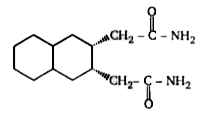WOLFF~KISHNER REDUCTION
Step-by-Step Text Solution for Wolff-Kishner Reduction
Step 1: Understanding the Wolff-Kishner Reduction
The Wolff-Kishner reduction is a chemical reaction used to convert aldehydes and ketones into alkanes. This process involves the reduction of the carbonyl group (C=O) present in these compounds.
Step 2: Formation of Hydrazone
The first step in the Wolff-Kishner reduction is the reaction of the carbonyl compound (aldehyde or ketone) with hydrazine (H2N-NH2). This reaction leads to the formation of a hydrazone. The general reaction can be represented as follows:
R1C(=O)R2+H2N-NH2→R1C=N-NH2R2+H2O
Here, R1 and R2 represent the alkyl or aryl groups attached to the carbonyl carbon.
Step 3: Treatment with Base
After the formation of the hydrazone, it is treated with a strong base, typically in the presence of ethylene glycol. The base facilitates the removal of nitrogen gas (N2) and leads to the formation of an alkane. The reaction can be summarized as:
R1C=N-NH2R2Base, Heat−−−−−−→R1C-H+R2H+N2
Step 4: Final Product
The final product of the Wolff-Kishner reduction is an alkane, which is formed by the complete reduction of the carbonyl group. The overall transformation can be summarized as:
R1C(=O)R2→R1C-H+R2H
Summary
The Wolff-Kishner reduction is a method to convert aldehydes and ketones into alkanes through the formation of hydrazones, followed by treatment with a base and heat to eliminate nitrogen gas.
---
The Wolff-Kishner reduction is a chemical reaction used to convert aldehydes and ketones into alkanes. This process involves the reduction of the carbonyl group (C=O) present in these compounds.
The first step in the Wolff-Kishner reduction is the reaction of the carbonyl compound (aldehyde or ketone) with hydrazine (H2N-NH2). This reaction leads to the formation of a hydrazone. The general reaction can be represented as follows:
After the formation of the hydrazone, it is treated with a strong base, typically in the presence of ethylene glycol. The base facilitates the removal of nitrogen gas (N2) and leads to the formation of an alkane. The reaction can be summarized as:
The final product of the Wolff-Kishner reduction is an alkane, which is formed by the complete reduction of the carbonyl group. The overall transformation can be summarized as:
The Wolff-Kishner reduction is a method to convert aldehydes and ketones into alkanes through the formation of hydrazones, followed by treatment with a base and heat to eliminate nitrogen gas.
Similar Questions
Knowledge Check
Wolff rearrangement
When α-Diazoketones are photo-irradiated or heated at high temperature or reacted with silver oxide or silver salts at room temperature, they loose nitrogen and rearrange to form ketene.
The ketenes reacts rapidly with water, alcohol and amines. Therefore, the reactions called Wolff-rearrangement.

 Product (A) is : A
Product (A) is : A B
B C
C D
D
Wolff rearrangement
When α-Diazoketones are photo-irradiated or heated at high temperature or reacted with silver oxide or silver salts at room temperature, they loose nitrogen and rearrange to form ketene.
The ketenes reacts rapidly with water, alcohol and amines. Therefore, the reactions called Wolff-rearrangement.

 Major product of the reaction is : A
Major product of the reaction is : A B
B C
C DNone of these
DNone of theseWolff rearrangement
When α-Diazoketones are photo-irradiated or heated at high temperature or reacted with silver oxide or silver salts at room temperature, they loose nitrogen and rearrange to form ketene.
The ketenes reacts rapidly with water, alcohol and amines. Therefore, the reactions called Wolff-rearrangement.

 , Product (A) is : A
, Product (A) is : A B
B C
C D
D
Stephen Reduction.
View Solution(a) Ilustrate the following name reactions :
(i) Hell - Volhard - Zelinsky reaction
(ii) Wolff - Kishner reduction reaction
(b) How are the following conversions carried out :
(i) Ethylcyanide to ethanoic acid
(ii) Butan - 1-ol to butanoic acid
(iii) Methylbezene to benzoic acid
View SolutionWrite the equation involved in the following reactions :
(i) Wolff-Kishner reductin (ii) Etard reaction
View SolutionIn Wolf - Kishner reduction, the carbonyl group of aldehydes and ketones is converted into
View SolutionWolff rearrangement
When α-Diazoketones are photo-irradiated or heated at high temperature or reacted with silver oxide or silver salts at room temperature, they loose nitrogen and rearrange to form ketene.
The ketenes reacts rapidly with water, alcohol and amines. Therefore, the reactions called Wolff-rearrangement.

 , Product (A) is :
, Product (A) is :
View Solution
